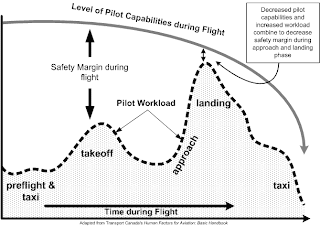The greatest workload during any flight happens during the takeoff and landing phases. The graph below shows peak workload periods during a typical flight profile. In addition, the graph plots the performance capabilities of the pilot relative to the workload required thereby showing the safety margin a pilot might expect to have through all phases of the flight.
Reprinted from: Aviationknowledge.wikidot.com
Because the flying workload is significant during takeoff and landing operations, pilots have devised more than a few memory aids to help them work through procedural checklists and flows. During my early flight training days I was taught the pre-takeoff acronym LHATTS to help ensure I captured many of the steps needed for a safe departure. This acrynom covered:
Landing Lights - to meet the FAA's Operation Lights On safety recommendation
Heading Indicator - align heading indicator (HI) with compass and verify HI is aligned with runway heading
Altimeter - verify that altimeter was set to the proper ATIS pressure setting and field elevation
Transponder - verify that the transponder was set to the proper code and turned to ALT
Time - check the "time off" or takeoff roll time for flight planning and ATC reporting purposes
Switches - verify that appropriate cockpit switches are set e.g., lights, boost pumps (if required), etc. OR
Seat Belts - verify that all souls are belted in appropriately
On the landing end of the flight, my initial instructors also provide me with the acronym GUMPS.
Gas - set the fuel selector to the appropriate (fullest) fuel tank
Undercarriage - verify gear down, primarily for retractable gear aircraft to ensure you got the gear down before landing
Mixture - adjust the mixture to the landing setting as you descend to more dense air at a lower altitude
Prop - adjust the prop setting (adjustable speed only) to high RPM in case a go-round was required
Switches - verify that appropriate cockpit switches are set e.g., lights, boost pumps (if required), etc. OR
Seat Belts - verify that all souls are belted in appropriately
These were only two of the acronyms I, and many other pilots, have been taught over the years to help reduce workload and improve cockpit efficiency. To be sure, an acronym or similar flow check should never be a substitute for the aircraft procedures checklist. However, acronyms are a good way to quickly make needed configuration changes, before verifying they have been done properly with the aircraft checklist.
The use of acronyms in aviation, not only as memory aids, but also as shorthand for a variety of flight related items, is so prevalent that understanding what they all mean can be a daunting task for new pilots. That's why it's a good idea to start collecting and understanding them early in your flight training.
Happy Landings

No comments:
Post a Comment